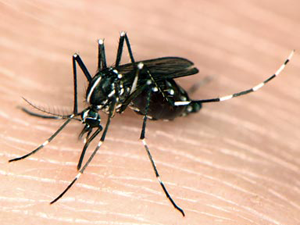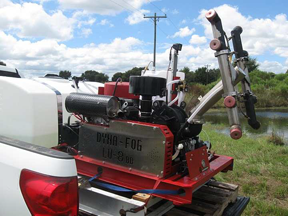In Urban Jungle, Tiger Mosquito Falls Prey to Killer Bacteria
 |
|
Distinctive white stripes adorn the tiger mosquito, which prefers to feed on humans and livestock but will also bite birds. Photo: Susan Ellis, Bugwood.org |
City neighborhoods are home-sweet-home for Asian tiger mosquitoes, among the most invasive pests in North America. Their bite would be bad enough, but these bugs can also carry a suite of unpleasant diseases: West Nile virus. Encephalitis. Dog heartworm. And that’s just for starters.
The Northeastern IPM Center is funding research seeking safe ways to cope with these small and skittish but trigger-quick pests. At Rutgers University, George Hamilton and Greg Williams head a team of scientists working on new ways to get tiger mosquito biocontrol into urban settings. They want to use this pest’s natural enemies against it.
How to Beat the Buzz
Until now, broad-spectrum pesticides such as pyrethroids or malathion that kill adult insects have been the only answer. But for tiger mosquitoes, these pesticides are a poor choice. Most mosquito control teams spray in the evening when skeeters start biting; because tiger mosquitoes attack during the heat of day, sprays evaporate too quickly to do much good. And even if they worked well, tiger mosquitoes could evolve resistance to them. “Plus there’s the potential for effects the pesticides could have on people and other animals,” Williams says.
Bacillus thuringiensis israelensis (Bti) is a natural bacterial disease that afflicts mainly mosquitoes and a few other members of the fly clan. It kills mosquito larvae before they have a chance to become adults and lay more eggs. But Bti hasn’t been widely used in urban settings, so the team wanted to develop a Bti treatment approach that could work almost anywhere.
To cope with a pest, you need to understand it. In nature, tiger mosquitoes breed in water-filled holes in trees—say, where a branch broke off the trunk, leaving a cavity behind. In fact, tiger mosquitoes can’t breed anywhere there’s soil: not in a pond or even a mud puddle. But roof gutters, birdbaths, old tires, or discarded cups make fine substitutes for tree cavities. Ten days in a tablespoon of water is all it takes for their larvae to morph into adults.
 |
|
A low volume of Bti larvicide drifts from sprayer nozzles and settles in containers of live mosquito larvae, providing quick, efficient control. Photo by Ary Sarajollahi |
A Tiger in the Tank
The challenge for this team was how to distribute the Bti spray at a scale that would control the pest in urban neighborhoods. At first they ran into a series of snags. The Bti solution didn’t flow properly through the nozzles of truck-mounted mosquito foggers they’d planned to use, which were designed for conventional pesticides. Yet when the team tested their mix with backpack sprayers, they found that larvae-infested containers came clean.
Since a truck-mounted sprayer can cover more territory, faster, than a backpack sprayer, the team turned to the mist sprayers typically used in small orchards. And that’s when they began to see the results they hoped for. While they haven’t tested and compared all available types of sprayers, Williams says, “we’re comfortable recommending the specifications a mosquito-control program needs to look for as they consider which piece of equipment to buy.”
Mosquito-control programs in two New Jersey counties put these methods to work in 2011. “Sometimes they work really well,” says Williams. “Sometimes results are mediocre. Now we need to refine the systems so they always deliver.”
— by MARY WOODSEN
The Northeastern IPM Center promotes integrated pest management for reducing risks to human health and the environment. If republishing our news, please acknowledge the source (“From Northeast IPM Insights”) along with a link to our website.
